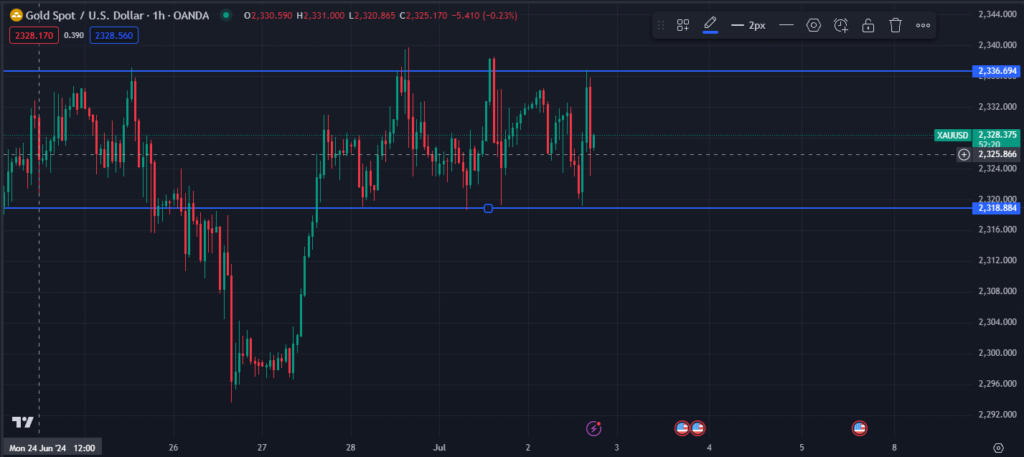Gold is experiencing downward pressure as it trades below the 50-day SMA on Tuesday. Last week, XAU/USD broke above a trendline connecting the “Head” and “Right Shoulder” of a previously invalidated Head and Shoulders (H&S) pattern formed between April, May, and June on the daily chart.
While the possibility of a more complex bearish “multi-shouldered” topping pattern still exists, the likelihood has decreased following the trendline break.
If Gold manages to surpass the $2,340 mark, it could target $2,369, representing the high from June 21. Further upside beyond that could aim for $2,388, the high seen on June 7.
Conversely, a breach of the compromised topping pattern’s neckline at $2,279 may trigger a reversal, potentially targeting $2,171, which is derived from the 0.618 ratio of the pattern’s height extrapolated lower.
Currently, the short and medium-term trends for Gold are sideways, while the long-term trend remains bullish.

Fundamental Overview:
Gold (XAU/USD) remains within the $2,320-$2,330 range, trading just below the 50-day Simple Moving Average (SMA) on Tuesday. According to Kitco’s Jim Wyckoff, Futures traders are engaged in short-covering, while longer-term investors are engaged in bargain hunting. This phase of accumulation suggests that investors are positioning themselves for a potential upswing in Gold, bolstered by ongoing global factors that support a bullish long-term outlook.
Geopolitical tensions in the Middle East and Ukraine, political shifts in Europe, and global trade fractures exemplified by the expansion of the BRICS trading bloc are contributing to Gold’s appeal as a safe-haven asset amidst uncertainty. As an alternative to the dominant US Dollar, Gold emerges as a pivotal player in the evolving global economic landscape.
Gold faces resistance as the US Federal Reserve (Fed) remains cautious about committing to interest rate cuts. The delay in rate cuts continues to pose an opportunity cost for holding Gold, which does not yield interest. However, once the Fed initiates rate cuts, it is expected to provide a supportive environment for Gold prices.
Despite the US Personal Consumption Expenditures (PCE) Price Index aligning with expectations in May, approaching the Fed’s 2.0% inflation target, Fed officials remain hesitant to signal imminent rate cuts. Richmond Fed President Thomas Barkin highlights ongoing delays in the impact of monetary tightening, while San Francisco Fed President Mary Daly acknowledges progress in inflation control but refrains from specifying a timeline for rate adjustments.
Market sentiment anticipates further insights from Fed Chairman Jerome Powell and closely monitors upcoming US economic data, including JOLTS Job Openings and Nonfarm Payrolls, for indications on future interest rate policies and their potential impact on Gold.
Although recent US ISM Manufacturing PMI data and rising Treasury yields amid speculation of a second term for President Trump had minimal impact on Gold, geopolitical risks associated with Trump’s policies continue to support Gold’s safe-haven appeal, countering conventional market expectations.
Market expectations, as reflected in the CME FedWatch tool, suggest a growing likelihood of Fed rate cuts by September, stabilizing around a 65% probability, underscoring continued optimism in Gold markets amidst evolving economic dynamics.
.

